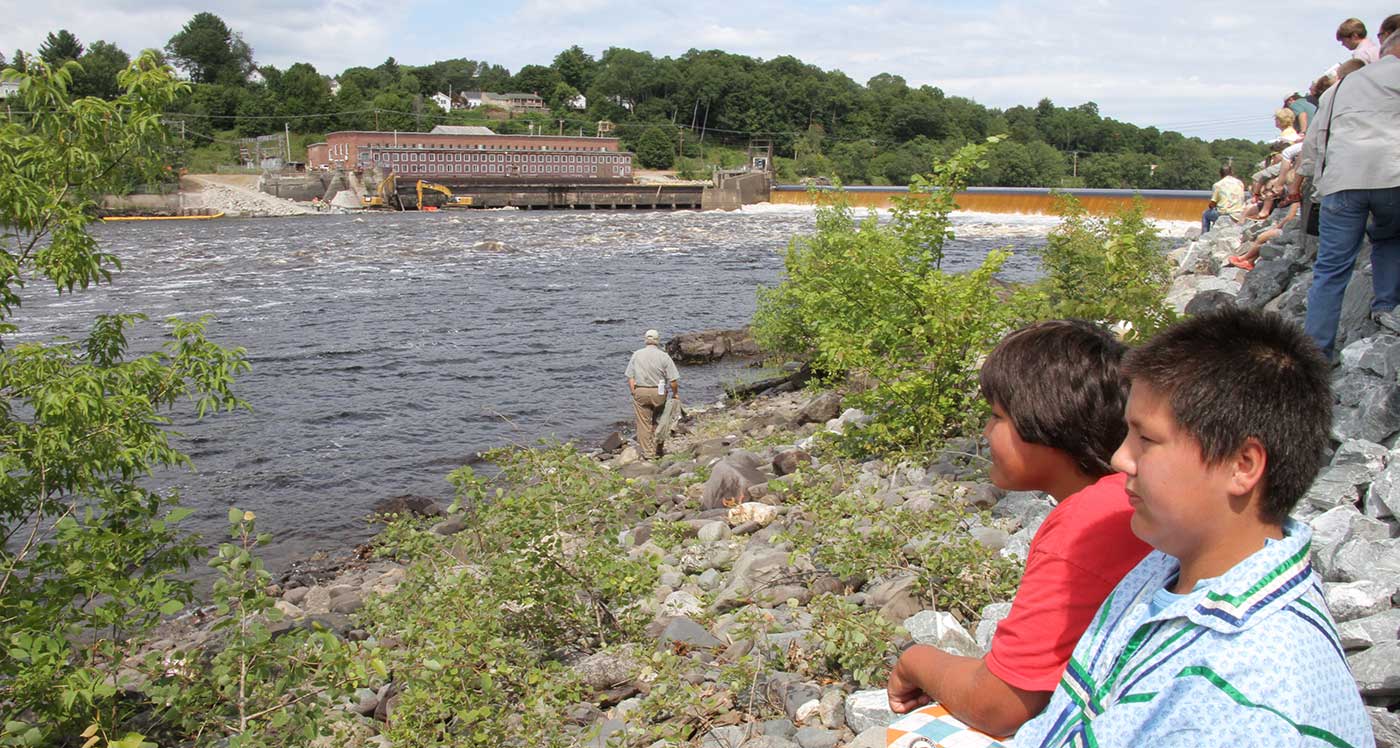The Penobscot River
New England's second largest river system, the Penobscot drains an area of 8,570 square miles. Its West Branch rises near Penobscot Lake on the Maine/Quebec border; the East Branch at East Branch Pond near the headwaters of the Allagash River. The main stem empties into Penobscot Bay near the town of Bucksport.
The river is tidal from the base of the former Veazie Dam to its mouth near Bucksport (approx. 25 miles) and is brackish to the town of Hampden. The river's total fall from Penobscot Lake on the South Branch is 1,602 feet.
Restoring the Penobscot
The Penobscot River Restoration Project (the Project) was a collaborative effort to balance fisheries restoration and hydropower production in Maine’s largest watershed. NRCM is a proud founding member of this effort and, working with others, was been instrumental in its success. View a full timeline of the Project at the bottom of this page.
The Project:
- Opened up 2,000 miles of rivers and streams to sea-run fish like the Atlantic salmon and shad.
- Maintained hydropower production and is one of the nation’s most innovative river restoration projects.
- Removed two dams that blocked fish migrations for more than a century—the Great Works Dam and the Veazie Dam—and constructed an innovative, river-like bypass around the third dam on the river at Howland. Fish are using this bypass to access historic habitat.
Improved Access to 2,000 Miles of the River
This project began in 1999. In June 2004, after five years of negotiations, the Penobscot River Restoration Trust signed an agreement for a public-private effort to maintain hydropower and restore sea-run fisheries on the Penobscot.
The Trust:
- Completed the project in 2016, and it has vastly improved access for Atlantic salmon and other sea-run fish to nearly 2,000 miles of their historic river and stream habitat.
- Removed the Great Works Dam in 2012 and the Veazie Dam in 2013 to open up the lower river.
- Completed a stream-like bypass channel around the Howland Dam in 2016.
- Purchased all three dams in previous years. The dams’ owners increased hydropower production at six other sites, resulting in at least as much hydropower production as before the dam removals.
Now, communities are developing new economic opportunities and recreational activities related to the river’s restoration.
Scientists are documenting the benefits of the project, and some Trust partners are improving fish passage on tributaries upstream from the project area.
Project Benefits
The river and its tributaries flow from Katahdin through the heart of Maine to Penobscot Bay. It is the largest river system in Maine—draining more than one-quarter of the state. The river connects the mountains to the sea, delivering ecological benefits and opportunities for recreation, economic development, and cultural enrichment. The Penobscot Project benefits the watershed by:
- Providing unobstructed access to 100% of historic habitat for Atlantic and shortnose sturgeon and striped bass;
- Improving access to 2,000 miles of river and stream habitat for endangered Atlantic salmon and other species of sea-run fish;
- Restoring ecological systems that benefit native plants and animals in the river, estuary, and Gulf of Maine;
- Creating a cleaner, healthier river;
- Supporting the Penobscot Nation’s culture and traditions;
- Offering new opportunities for economic and community development in riverside communities;
- Enhancing outdoor recreation such as fishing, paddling, and wildlife watching; and
- Maintaining hydropower generation.
Project Restored the Connections between the Gulf of Maine and Inland Waters
Native sea-run fish—such as river herring and shad—have rebounded. These fish provide food for many fish-eating birds and mammals, including eagles, porpoises, and river otters. Over time, the increase in sea-run fish populations will help to restore commercial coastal ground fisheries as well.
Signs of Renewal
Sea-run fish are heading into newly accessible habitat. Almost no shad used the fishway at the former Veazie Dam, but in 2017, nearly 4,000 shad used the fish lift at the Milford Dam, now the first on the river. Anglers now catch shad in places that were inaccessible to this excellent game fish for a century. Nearly 1.2 million river herring used the Milford fish lift in 2017, up from essentially zero river herring passing upstream of this area just three years ago. Sturgeon are also reaching their historic spawning grounds and even entering the Milford fish lift! The Penobscot Nation has hosted three national whitewater canoe races on the newly free-flowing river above Old Town.
Dam owners increased hydropower generation at six dams in and near the Penobscot. This allowed energy generation to remain consistent with previous levels despite the removal of two dams and the decommissioning of a third.
Timeline of the Penobscot Project
The Penobscot Project happened incrementally over several years, and involved restoring the river through three major construction projects, changes in energy operations and re-licensing requirements, a variety of permit obligations, outreach to communities within the project area and to the public at large, planning for economic and community development activities related to the river's restoration, and significant private and public fundraising.
The final investment of the project came to $63 million, raised from private sources and federal government programs to support project implementation, including dam removal and modifications, complying with permit requirements, and engaging in economic development projects.
Timeline of work:
June 25, 2004: The Lower Penobscot River Settlement Accord, the multi-party agreement laying the framework for the project, was signed. Once energy enhancements were approved, PPL Corporation began implementing them, and addressed impacts of energy operations on Penobscot Nation tribal lands.
Late 2007: The Trust reached a fundraising goal of $25 million needed to purchase the Veazie, Great Works, and Howland Dams.
June 20, 2008: Exercised the option to move forward on dam purchases
November 7, 2008: The Penobscot Trust filed for federal and state permits required to purchase the dams. During the federal and state permitting process the public was encouraged to comment on multiple occasions. In addition, the Penobscot Trust held formal public scoping sessions in December of 2007 as part of this process.

Watching the breaching of the Veazie Dam in 2013.
December 17, 2010: After receiving necessary federal and state permits, and undergoing all necessary legal due diligence, the Penobscot Trust purchased the Veazie, Howland, and Great Works Dams.
2012: Great Works Dam was removed.
2013: Veazie Dam removal began.
2016: Howland bypass was completed.
Partners
The Penobscot River Restoration Trust was a nonprofit organization consisting of the Penobscot Nation, American Rivers, Atlantic Salmon Federation, Maine Audubon, Natural Resources Council of Maine, The Nature Conservancy, and Trout Unlimited.
Additional Partners in the Project included PPL Corporation, Black Bear Hydro LLC, U.S. Fish and Wildlife Service, Bureau of Indian Affairs, National Park Service, National Oceanic and Atmospheric Administration, State of Maine’s Department of Marine Resources, Maine Department of Inland Fisheries and Wildlife, and the former Maine State Planning Office, and the Penobscot River Restoration Trust and its members.
NRCM was a founding member of the Trust. This is one more example of our commitment to protecting and restoring Maine’s environment, now and for future generations.

Book Celebrates River Restoration
The book, From the Mountains to the Sea, tells the stories of people involved in this 16-year river restoration project.
Watch Penobscot Webinar NRCM and our partners hosted a webinar about the Penobscot project, which you can watch below. Hear from John Banks of the Penobscot Indian Nation; Laura Rose Day, the executive director of the Penobscot River Restoration Trust; Kate Dempsey of The Nature Conservancy; Andy Goode of the Atlantic Salmon Federation; and NRCM's advocacy director Pete Didisheim.













